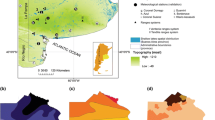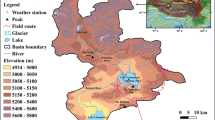Abstract
The purpose of this study is to analyze the temporal dynamics of the free surface area of shallow lakes during the period 1984–2015 in the Pampas region, Argentina, using satellite image processing (Landsat 4 TM, Landsat 5 TM, Landsat 7 ETM+ and Landsat 8 OLI). The evolution of the free surface of five shallow lakes in two distinct basins of the province of Buenos Aires can be explained using generalized linear models (GLM) and taking as explanatory variables the accumulated precipitation and the number of rainfall days over a given period before the acquisition date of the satellite image. Accumulated precipitation and frequency of days with precipitation were calculated for 1, 7, 30, 90, and 180 days, as well as for 1, 2, 3, and 4 years, respectively. The results show that the explanatory variables linked to the memory of the system (3 and 4 years) contribute significantly in all cases to the reconstruction of the areas. In particular, long-term variables reconstruct accurately (R2 between 0.76 and 0.91) the area of the five shallow lakes for the period 2001–2015. The short-term explanatory variables (7 and 30 days) are also significant to the reconstruction of the variations observed in the first period (1984–2000) but only for the two lakes in the Southeastern basin (R2 = 0.70 and 0.94), while in the Center-South upper basin, only one of the lakes exhibits some short-term dependency in the second period (2001–2015) (R2 = 0.83).










Similar content being viewed by others
Data availability
The data will be available to anyone upon request.
References
Aliaga VS (2018) Variabilidad climática de la Región Pampeana y su efecto sobre las lagunas de la región. Tesis de doctorado. Departamento de Geografía y Turismo. Universidad Nacional del Sur
Ameghino F (1881) La formación pampeana o estudio sobre los terrenos de transporte de la cuenca del Plata. G. Masson, Paris
Ameghino F (1884) Excursiones geológicas y paleontológicas en la Provincia de Buenos Aires. Boletín Academia Nacional de Ciencias de Córdoba, Argentina
Beklioglu M, Altinayar G, Tan CO (2001) Role of water level fluctuations, nutrients and fish in determining the macrophyte-dominated clear water states in five Turkish shallow lakes. In: International workshop, pp 28–30
Benzaquen L, Blanco DE, Bo R, Kandus P, Lingua G, Minotti P, Quintana R (eds) (2017) Regiones de Humedales de la Argentina. Ministerio de Ambiente y Desarrollo Sustentable, Fundación Humedales/Wetlands International, Universidad Nacional de San Martín y Universidad de Buenos Aires
Blindow I (1992) Long-and short-term dynamics of submerged macrophytes in two shallow eutrophic lakes. Freshw Biol 28(1):15–27. https://doi.org/10.1111/j.1365-2427.1992.tb00558.x
Canziani OF (2003) Hidrología, recursos hídricos y cambio climático. Ing Sanit Ambient 67:53–57
Canziani OF, Forte Lay JA, Quintela RM, Troha A (1982) Study of great storms in the Low “Pampa” of Buenos Aires Province (Argentina) and their incidence on the hydrological balance. In: International congress on hydrology of great plains (CONAPHI)
Canziani GA, Ferrati R, Marinelli C, Dukatz F (2008) Artificial neural networks and remote sensing in the analysis of the highly variable Pampean shallow lakes. Math Biosci Eng 5(4):691–711
Carbone ME, Píccolo MC, Perillo GME (2003) Caracterización climática de la cuenca del arroyo Claromecó, Argentina. Papel Geogr 38:41–60
Cepeda R, Colasurdo V, Díaz O et al (2010) Elaboración de un índice de estado trófico adaptado a categorizar lagunas pampeanas. In: Varni M, Entraigas I, Vives L (eds). Libro Actas I Congreso Internacional de Hidrología de Llanuras, Tomo II, Hacia la gestión integral de los recursos hídricos en zonas de llanura, pp 385–392 (printed version) and pp 625–632 (digital version). ISBN 978-987-543-392-2.
Coe R, Stern RD (1982) Fitting models to daily rainfall data. J Appl Meteorol (1962–1982) 21(7):1024–1031
Coops H, Beklioglu M, Crisman TL (2003) The role of water-level fluctuations in shallow lake ecosystems–workshop conclusions. Hydrobiologia 506(1):23–27. https://doi.org/10.1023/B:HYDR.0000008595.14393.77
Dangavs N (1976) Descripción sistemática de los parámetros morfométricos considerados en las lagunas pampásicas. Limnobios 1(2):35–59
Dangavs N (2005) Los ambientes acuáticos de la provincia de Buenos Aires. In Barrio RE, Caballé MF, Llambias E (eds) Relatorio del XVI Congreso Geológico Argentino. La Plata, pp 219–236
de la Casa AC, Ovando GG, Nasello OB (2018) Changes in the intensity and variability of precipitation in the central region of Argentina between 1960 and 2012. Climate 6(3):66
Dukatz F, Ferrati R, Marinelli C, Cepeda R, Canziani GA (2009) Monitoring shallow lakes in the Pampas. In: Joshi PK (ed) Geoinformatics for natural resource management. NOVA Science Publishers, Inc., New York. ISBN: 978-160692-211-8
Ferrati R, Dukatz F (2007) Sistematización del análisis y clasificación de cuerpos de agua según permanencia mediante sensores remotos. In: Feyen J, Aguirre LF, Moraes M (eds) Congreso Internacional sobre Desarrollo, Medio Ambiente y Recursos Naturales: Sostenibilidad a Múltiples Niveles y Escala, vol II. Cochabamba, Bolivia, pp 1102–1107
Ferrati R, Marinelli C, Dukatz F, Cepeda R, Canziani GA (2007) Categorización de cuerpos de agua según sus propiedades ópticas. In: Feyen J, Aguirre LF, Moraes M (eds) Congreso Internacional sobre Desarrollo, Medio Ambiente y Recursos Naturales: Sostenibilidad a Múltiples Niveles y Escalas, vo1 II. Cochabamba, Bolivia, pp 1108–1115
García PE, Badano ND, Menéndez AN et al (2018) Influencia de los cambios en el uso del suelo y la precipitación sobre la dinámica hídrica de una cuenca de llanura extensa. Caso de estudio: Cuenca del Río Salado, Buenos Aires, Argentina. Ribagua 5(2):92–106. https://doi.org/10.1080/23863781.2018.1495990
Grassi B, Redaelli G, Canziani PO, Visconti G (2012) Effects of the PDO phase on the tropical belt width. J Clim 25(9):3282–3290. https://doi.org/10.1175/JCLI-D-11-00244.1
Grosman F (2008) Espejos en la llanura: Nuestras lagunas de la región pampeana. Universidad Nacional del Centro de la Provincia de Buenos Aires, Buenos Aires (ISBN 978-950-658-213-5)
Grosman F, Sanzano P, Díaz O et al (2007a) Lagunas de la Región Pampeana de Argentina: estructura y funcionamiento a partir de aspectos sociales, económicos, culturales y naturales. In: Feyen J, Aguirre LF, Moraes M (eds) Congreso Internacional sobre Desarrollo, Medio Ambiente y Recursos Naturales: Sostenibilidad a Múltiples Niveles y Escalas, vol II. Cochabamba, Bolivia, pp 1130–1137
Grosman F, Sanzano P, Rudzik G (2007b) Incidence of local and global changes on the dynamics of pampean shallow lakes: the case of Blanca Grande: 294–301. In: Scarpati O, Jones JAA (eds) Environmental change and rational water use. Orientación Gráfica Editora, p 458. ISBN 978-987- 9260-46-3
Hartkamp AD, De Beurs K, Stein A, White JW (1999) Interpolation techniques for climate variables. NRG-GIS Series 99-01. CIMMYT, Mexico, DF
Jeppesen E, Moss B, Bennion H et al (2010) Interaction of climate change and eutrophication. In: Kernan M, Battarbee RW, Moss B (eds) Climate change impacts on freshwater ecosystems. Wiley-Blackwell, Chichester, UK, pp 119–151
Keyantash J, National Center for Atmospheric Research Staff (eds) (2018) The climate data guide: standardized precipitation index (SPI). Retrieved from https://climatedataguide.ucar.edu/climate-data/standardized-precipitation-index-spi. Last modified 07 Aug 2018
Kosten S, Vernooij M, Van Nes EH, Gonzalez Sagrario MA, Clevers Jan GPW, Scheffer M (2012) Bimodal transparency as an indicator for alternative states in South American lakes. Freshw Biol 57(6):1191–1201. https://doi.org/10.1111/j.1365-2427.2012.02785.x
Maestri ML, Castets F, Bayala MI, Canziani GA (2019) Análisis comparativo de cinco métodos de procesamiento para calcular el área de lagunas pampeanas a partir de imágenes satelitales Landsat. Biol Acuát 33:3. https://doi.org/10.24215/16684869e003
Moss B, Mckee D, Atkinson D et al (2003) How important is climate? Effects of warming, nutrient addition and fish on phytoplankton in shallow lake microcosms. J Appl Ecol 40:782–792. https://doi.org/10.1046/j.1365-2664.2003.00839.x
Moss B, Kosten S, Meerhoff M et al (2011) Allied attack: climate change and eutrophication. Inland Waters 1:101–105. https://doi.org/10.5268/IW-1.2.359
Nelder JA, Wedderburn RWM (1972) Generalized linear models. J R Stat Soc Ser A (gen) 135(3):370–384. https://doi.org/10.2307/2344614
Pisano MF, D’Amico G, Ramos N, Pommarés N, Fucks E (2020) Factors that control the seasonal dynamics of the shallow lakes in the Pampean region, Buenos Aires, Argentina. J S Am Earth Sci 98:102468. https://doi.org/10.1016/j.jsames.2019.102468
Quirós R, Resella A, Boveri M, Rosso J, Sosnovsky A (2002a) Factores que afectan la estructura y funcionamiento de las lagunas pampeanas. Ecol Austral 12:175–185
Quirós R, Rosso JJ, Rennella AM, Sosnovsky A, Boveri MA (2002b) Análisis del estado trófico de las lagunas pampeanas (Argentina). Interciencia 27(11):584–591
Quirós R, Rennella AM, Boveri MA, Rosso JJ, Sosnovsky A (2002c) Factores que afectan la estructura y el funcionamiento de las lagunas pampeanas. Ecol Austral 12(2):175–185
Quiroz Londoño OM, Martínez DE, Dapeña C, Massone H (2008) Hydrogeochemistry and isotope analyses used to determine groundwater recharge and flow in low-gradient catchments of the province of Buenos Aires, Argentina. Hydrogeol J 16(6):1113–1127. https://doi.org/10.1007/s10040-008-0289-y
Requesens E, Silva L (2011) Tendencias en el uso de la tierra y diversidad productiva en establecimientos agropecuarios del centro-sur de la provincia de Buenos Aires (Argentina). AgriScientia 28(1):75–83. https://doi.org/10.31047/1668.298x.v28.n1.2785
Ringuelet RA (1962) Rasgos principales de las lagunas pampeanas con criterio bioecológico. Anal CIC 3:315–339
Scarpati OE, Capriolo AD (2018) Evolución del exceso de agua edáfica anual en la Región Pampeana (Argentina). Estud Geogr 79(285):375–395. https://doi.org/10.3989/estgeogr.201814
Solana MX, Quiroz Londoño OM, Romanelli A, Donna F, Martínez DE, Weinzettel P (2021) Connectivity of temperate shallow lakes to groundwater in the Pampean Plain, Argentina: a remote sensing and multi-tracer approach. Groundw Sustain Dev 13:100556. https://doi.org/10.1016/j.gsd.2021.100556
Stern RD, Coe R (1984) A model fitting analysis of daily rainfall data. J R Stat Soc Ser A (gen) 147(1):1–18. https://doi.org/10.2307/2981736
World Meteorological Organization (2012) Standardized precipitation index user guide (M. Svoboda, M. Hayes and D. Wood) (WMO-No. 1090). Geneva. http://www.droughtmanagement.info/literature/WMO_standardized_precipitation_index_user_guide_en_2012.pdf. Accessed 17/08/2022
Xu H (2006) Modification of normalised difference water index (NDWI) to enhance open water features in remotely sensed imagery. Int J Remote Sens 27(14):3025–3033. https://doi.org/10.1080/01431160600589179
Yang C, Chandler RE, Isham VS, Wheater HS (2005) Spatial–temporal rainfall simulation using generalized linear models. Water Resour Res 41(11):W11415. https://doi.org/10.1029/2004WR003739
Funding
The authors have not disclosed any funding.
Author information
Authors and Affiliations
Contributions
MML: conceptualization; data curation; formal analysis; investigation; methodology; resources; software; validation; visualization; roles/writing—original draft; writing—review and editing. FR: conceptualization; methodology; supervision; validation; visualization; writing—review and editing. CGA: conceptualization; methodology; project administration; resources; supervision; visualization; writing—review and editing.
Corresponding author
Ethics declarations
Conflict of interest
The authors declare no competing interests.
Additional information
Publisher's Note
Springer Nature remains neutral with regard to jurisdictional claims in published maps and institutional affiliations.
Rights and permissions
Springer Nature or its licensor (e.g. a society or other partner) holds exclusive rights to this article under a publishing agreement with the author(s) or other rightsholder(s); author self-archiving of the accepted manuscript version of this article is solely governed by the terms of such publishing agreement and applicable law.
About this article
Cite this article
Maestri, M.L., Ferrati, R.M. & Canziani, G.A. Variation in the area of the polymictic Pampean shallow lakes and its relationship with precipitation. Environ Earth Sci 82, 597 (2023). https://doi.org/10.1007/s12665-023-11301-7
Received:
Accepted:
Published:
DOI: https://doi.org/10.1007/s12665-023-11301-7




